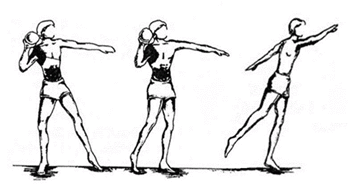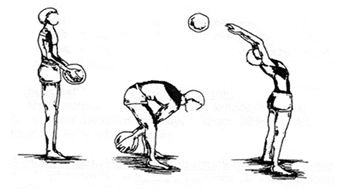VIII.5.1. Description of Hungarofit tests
- Standing long jumps, with two feet
Aim: to measure explosive leg power
Required resource: tape measure
Number of attempts: max. 3
Starting position: the athlete stands behind a line marked on the ground with feet slightly apart.
Task: A two foot take-off and landing is used, with swinging of the arms and bending of the knees to provide forward drive. The athlete attempts to jump as far as possible landing on both feet without falling backwards.

Illustration 8. Standing long jumps, with two feet
Scoring: the measurement is taken from take-off line to the nearest point of contact, with 1 cm accuracy, on the landing (back of the heels). Maximum three attempts are allowed. The assessment is done with the help of a table that gives a rating scale and it is converted into points.
- Pushing a thick ball with two hands from throwing spreader position
Aim: to measure dynamic force of the arm, trunk and leg muscles.
Required resources: until the age of 12 a 2kg thick ball, over the age of 12 a 3 kg ball.
Starting position: athlete stands in spreader position behind a line marked on the ground. The athlete’s feet do not touch the line; his/her weight is on the back, bent foot looking towards the throwing direction. The hand extends straight out towards the target acting as a pointer. When initiating the throw the ball is in the athlete’s throwing hand and he/she holds it above the shoulder at the throwing - side.
Task: students stretch their back with bent foot, turn the torso towards throwing direction, and stretch out with their throwing hand and throw the ball as far as possible. Their foot must not touch the line either before or during the process of throwing.

Illustration 9
Scoring: the distance between the middle of the line and the landing point is measured with 5 cm accuracy. Maximum three attempts are allowed. The longest distance is scored.
- Push-ups, bending arms and stretching until getting fatigue
Aim: to measure dynamic force-power, stamina and strength of the shoulder- and arm- muscles.
Required resource: stopwatch
Time: max. 1, 5 min for females/ girls and max 4 min. for males/ boys
Starting position: before starting athletes should set themselves up properly. They place hands wider, chest should be in line with hands, fingers face forward, feet are closed, and knees are bent. Athletes push away from the floor, straighten the arms until they return to the set up.
Task: with steady tempo athletes bend and stretch the arm while torso remains straight.

Illustration 10
Scoring: within a specified time, without stopping, the number of regular attempts is recorded and points are calculated on the basis of the specified scores.
- Throwing thick ball backwards with two hands, above the head.
Aim: measuring the dynamic force of the shoulder- and torso muscles.
Required resource: until the age of 12 a 2kg thick ball, over the age of 12 a 3 kg ball, tape measure.
Number of attempts: maximum three.
Starting position: standing against throwing direction in spreader position behind the thrower. The ball is in the hands, arms are bent while holding the ball.
Task: while bending the hip, the ankle and the knee and ball is pushed between the legs with stretched arms. By stretching the feet and lifting up the hip athletes gain momentum and throw the ball backwards. Until the ball is in their hands they must stand behind the line, which must not be touched.

Illustration 11
Scoring: the distance between the middle of the line and the landing point of the ball is measured with 5 cm accuracy. Maximum three attempts are allowed.
- From prone position torso lift- and arm bent, until getting tired
Aim: to measure the power/ force of back muscles.
Required resources: stopwatch, mat
Time: maximum 4 minutes.
Starting position: athlete lies on his/ her abdomen, both hands are on the nape, touches the mat with the forehead and bend the arms, tightens the abdominal muscles and fixes the pelvis, then holds this position throughout the exercise. (Feet must not be pressed down with the help of some external force).
Task: athlete lifts the hip with quick steady tempo/ space while also lifting up the arms. He/she contacts the elbows then stretches the arms again and descends the torso with the arms back to the ground.

Illustration 12
Scoring: within a specified time without stopping the number of attempts is counted and it is recorded by using a score based table.
- Sit ups from supine position, descending back until getting tired
Aim: to measure the force/ power of abdominal muscles
Required resources: stopwatch, mat
Time: maximum 4 minutes.
Starting position: athlete lies on a mat, lies on his/ her back while bending both knees at 90 degree angle, puts the feet on to wall bars, or keeps them on the mat; elbows are pointed forwards, he/ she supports on the fingers behind the ears and flattens the stomach. (Feet must not be pressed down with the help of some external force).
Task: with quick steady tempo/ space athlete sits up so as to be able to lift his/ her cervical spine section gradually, touches his/ her thighs with the elbows, plants his/ her feet flat, raises the torso off the floor, then descends back and returns to the starting position.

Illustration 13
Scoring: within a specified time without stopping the number of regular attempts is counted and it is recorded by a score based table.
- Cooper test (12 minute run)
Aim: to measure aerobic endurance/ stamina
Required resources: stopwatch, whistle, measured track
Time: 12 minutes
Starting position: athlete stands behind the starting line.
Task: when the command “go” is given the athlete commences the test and runs/ jogs for 12 minutes without stopping. When 12 minutes have elapsed and the whistle is blown the athlete stays where he/ she stopped until the trainer/ PE teacher has recorded the distance.
Assessment: the total distance covered within 12 minutes is recorded and by using a distance score table the result of the test is estimated.